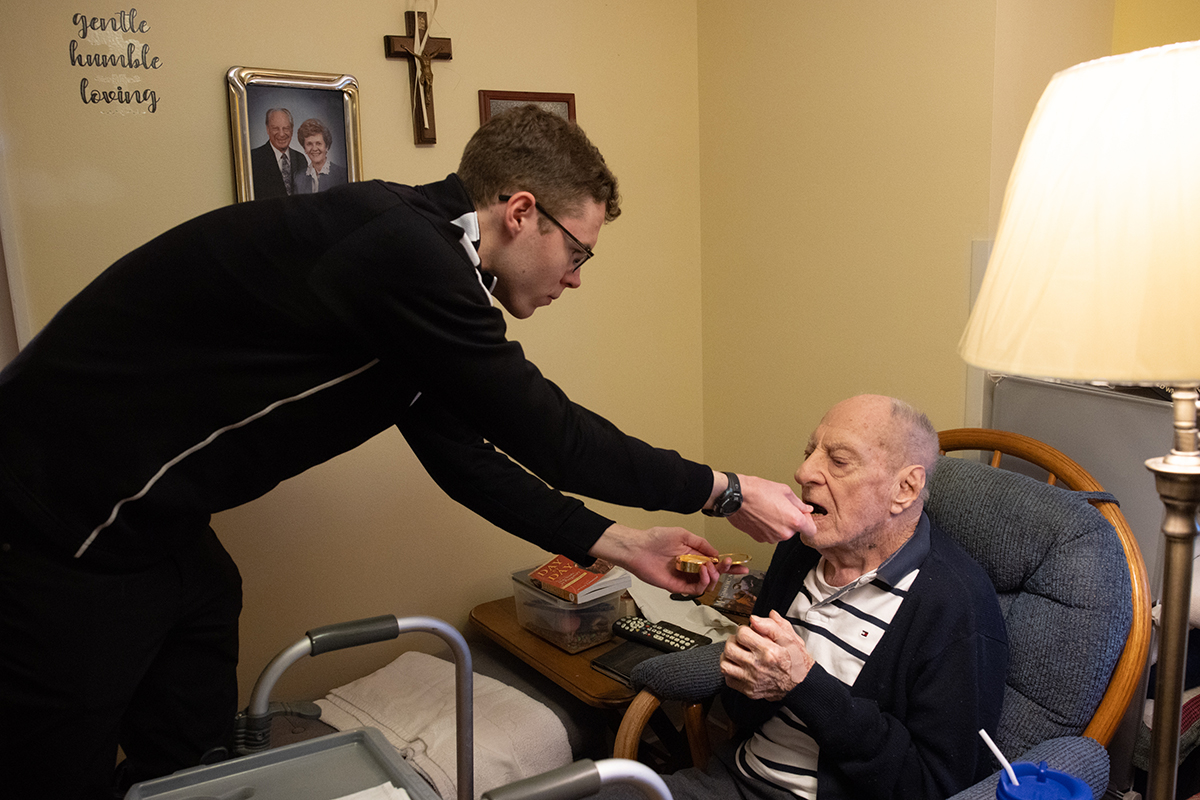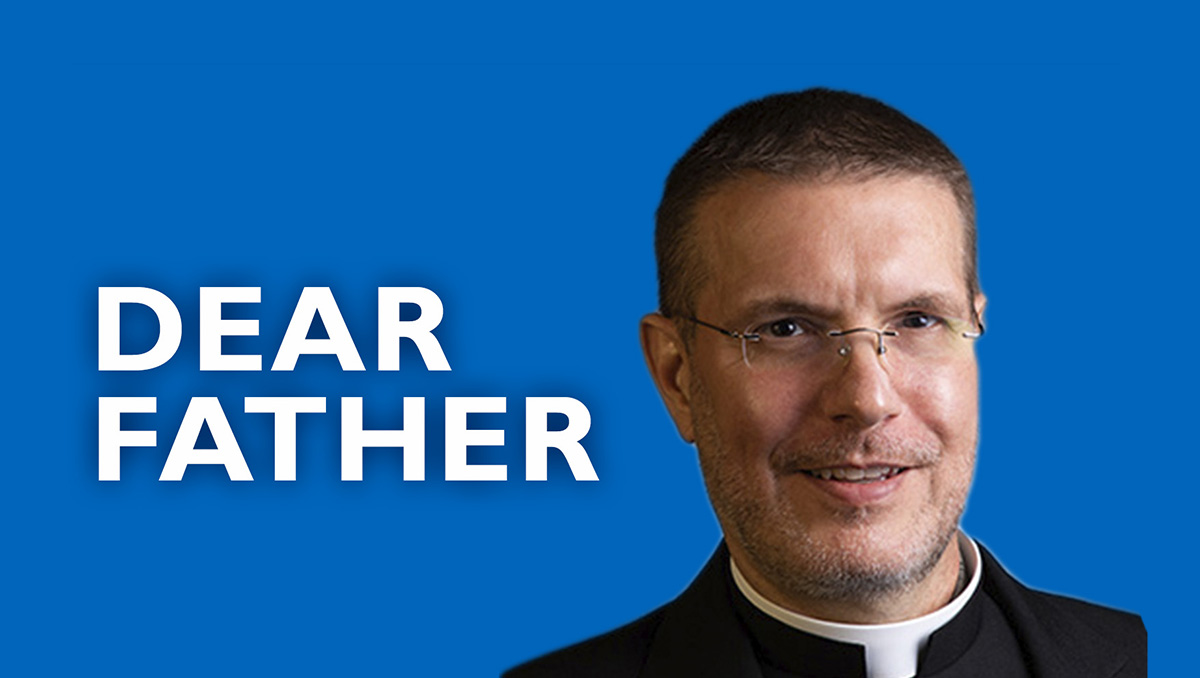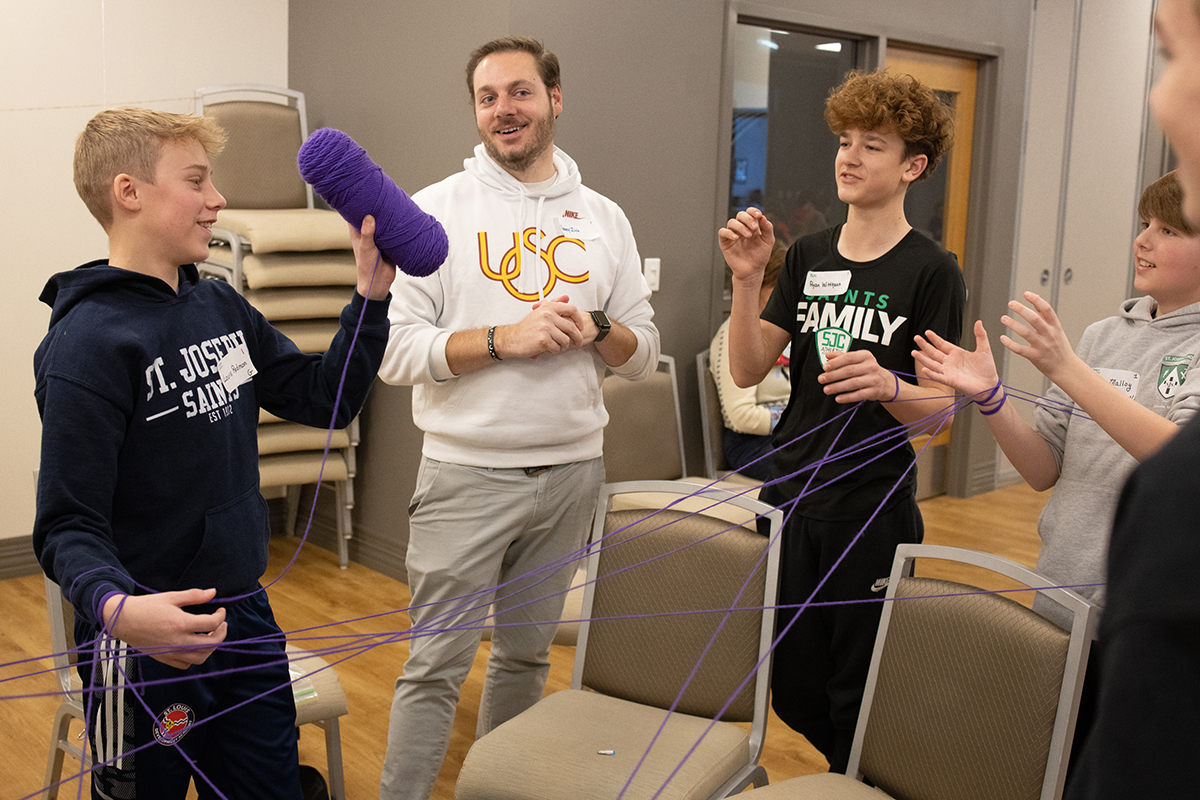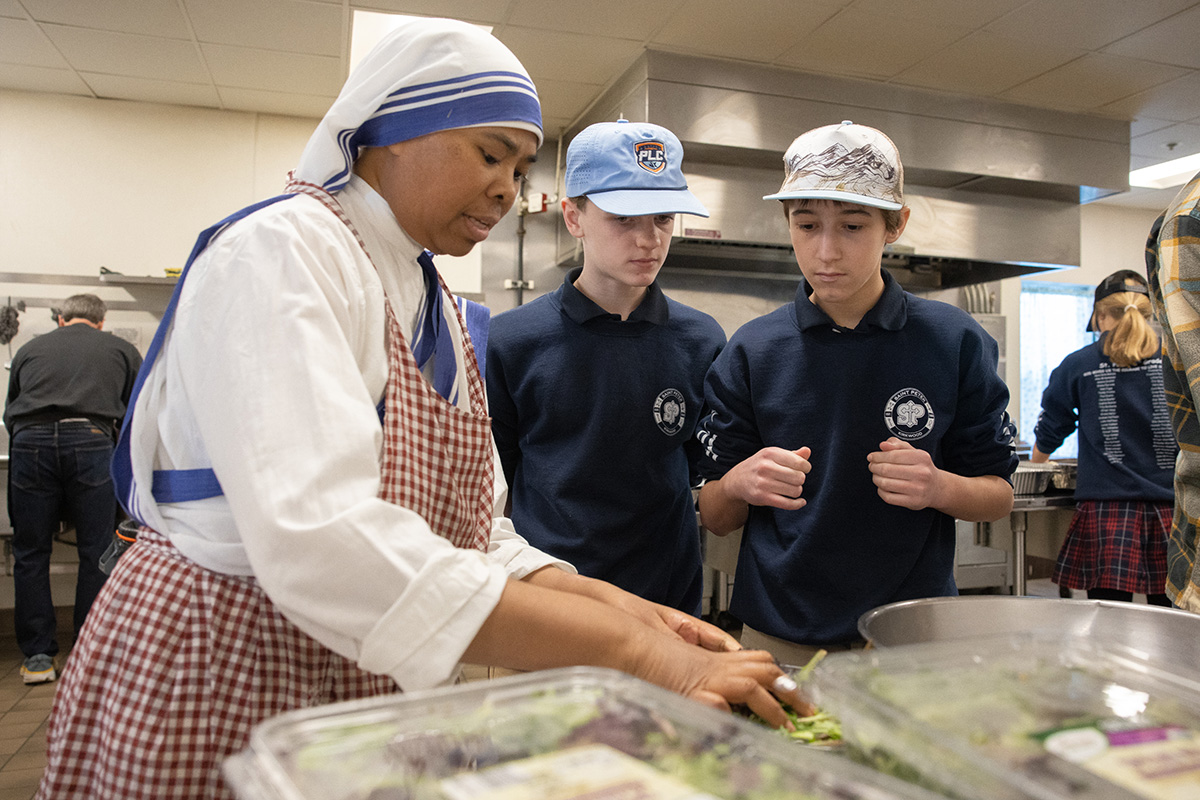Advent joy | Confession helps us prepare for Christmas

Confession serves as the bridge between the birth of Jesus and His Second Coming, and removes hindrances to the joyful reception of the Eucharist in the present.
The sacrament of reconciliation figuratively wipes the slate clean in any liturgical season, but Advent provides a poignant time to experience the joy of reconciling with God and the Church, being one with Christ in the here and now, while celebrating His First Coming in His birth in Bethlehem and preparing for His Second Coming and all eternity.
In the confessional, a penitent confesses sins, receives absolution from a priest and emerges unburdened, joyful and reborn.

“There’s a transformation,” Auxiliary Bishop Mark S. Rivituso said. “Jesus meets us where we are, He knows our needs and He lifts us up in those times where we’re downtrodden and beaten down by the burden of sin. In the sacrament of reconciliation, with the priest acting as the person of Jesus, He frees us of that so we can be truly living out the joy of missionary discipleship.
“I pray that priests will be joyful confessors. We’re really there to help.”
Advent, the four Sundays preceding Christmas, is a perfect time for receiving the sacrament, and one of two times in the liturgical year in which the Catholic Church recommends going to confession (though more is best). The other is Lent in preparation for Jesus’ crucifixion and resurrection on Easter Sunday to start the Easter season.
The joy of Advent
For Bishop Rivituso, a liturgical prayer formerly used at Mass stands out as “a good way to integrate the spirit of the Advent season — a season of hope but also a season also of great joy.”
“In that prayer, we ask the Father for the graces to remove the things that hinder us from receiving Christ with joy,” he said, adding that the prayer demonstrates “the importance of reconciliation. … What are those things that are hindering us from receiving Christ with joy? One of those things is sin.”
Advent prepares Catholics not only for the commemoration of Christ’s birth in a Bethlehem manger 2,000 years ago, but for His glorious Second Coming at the end of the world. The first two Sundays of Advent focus on the Second Coming; the last two on the first.
“We shouldn’t be fearful of the Second Coming, but be truly prepared with a joyful spirit knowing that we’re living an imitation of His ways,” Bishop Rivituso said. “If we’re not living an imitation of His ways as joyful missionary disciples, it’s important to see the significance of reconciliation. (Reconciliation is) a way not only to become more joyful but also to grow in virtue, to grow in Christ. How better to prepare ourselves for Jesus when He comes in all His glory than to truly be joyful and living His way in our lives?
“It reminds us that one day we will meet the Lord, if not in the end times at the Second Coming but (in) our own second coming with Jesus when we die. We want to be prepared.”
Reconciliation requires a penitent to be humble, just as Jesus “humbled Himself to share in our humanity,” as a priest says over the gifts just before the Eucharistic prayer at Mass. Similar to Christ, penitents humble themselves in reconciliation. In the examination of conscience, sin is acknowledged, then it’s addressed and absolved in the confessional. Penance comes next, outside the confessional as the last step of the sacrament.
“We come before the Lord humbly in reconciliation like He came humbly among us in Bethlehem; He humbled Himself to model for us who we are called to become,” Bishop Rivituso said. “We need to be humble and have the courage to say, ‘I’m a sinner and need your mercy so I can remove the things in my heart that really keep me from receiving You with joy.’
“We come to know our true identity that we are sinners, we need a Savior and we need to know the mercy of the Savior in the sacrament of reconciliation so we can be joyful missionaries disciples”
The bridge of Advent
With Advent focusing on both the past and future, confession and the Eucharist serve as the bridge between the two.
“Yes, Christ came into the world 2,000 years ago. Yes, He will come again at the end of time. But He comes in the middle, too – into our lives, as a path between the first coming and the last,” said Ed Hogan, academic dean and theology professor at Kenrick-Glennon Seminary. “There He is reconciling us to the Father again and again.”
Kenrick-Glennon theology professor Lawrence Feingold calls penance “a beautiful place to help us prepare for the Eucharistic encounter in the light of the first coming and second. … Confession and the Eucharist are two different kinds of encounters. The encounter in confession, with all of our messiness and sins, and His mercy and purification, helps us embrace Him in a eucharistic encounter joyfully and wholeheartedly.”
In portending the Second Coming, Advent enables Catholics “to put ourselves imaginatively in that context. I have to realize, ‘Will I be ready for the end of of times? Well, am I ready right now?’” Hogan said. “The whole feeling of Advent is this joyful anticipation. I can look at my sins in the light of hope and anticipation; that’s what we should experience all the time.”
Bound by the seal of confession, priests are ready and willing to renew the darkness of person’s life with the light of absolution, in the name of Jesus Christ. It’s an honor for them to serve in this way, to experience a person’s humility in admitting to sin and failure, yet absolving them and sending them away joyfully unburdened.
“People have a right to this most personalized encounter with Christ,” said Feingold, then paraphrasing Cardinal John Henry Newman. “Who wouldn’t want (confession), to be able to unburden oneself of these cares to somebody bound by the seal of confession and giving us a counsel personalized for the benefit of our salvation.”
Tips for the sacrament of reconciliation
PREPARATION: Before going to confession, take some time to prepare. Begin with prayer, and reflect on your life since your last confession. How have you — in your thoughts, words, and actions — neglected to live Christ’s commands to “love the Lord, your God, with all your heart, with all your soul, and with all your mind,” and to “love your neighbor as yourself” (Matthew 22:37, 39)? As a help with this “examination of conscience,” you might review the Ten Commandments or the Beatitudes (Exodus 20:2-17; Deuteronomy 5:6-21; Matthew 5:3-10; or Luke 6:20-26).
GREETING: The priest will welcome you; he may say a short blessing or read a Scripture passage.
THE SIGN OF THE CROSS: Together, you and the priest will make the Sign of the Cross. You may then begin your confession with these or similar words: “Bless me, Father, for I have sinned. It has been (give days, months, or years) since my last confession.”
CONFESSION: Confess your sins to the priest. If you are unsure what to say, ask the priest for help. When you are finished, conclude with these or similar words: “I am sorry for these and all my sins.”
PENANCE: The priest will propose an act of penance. The penance might be prayer, a work of mercy, or an act of charity. He might also counsel you on how to better live a Christian life.
ACT OF CONTRITION: After the priest has conferred your penance, pray an Act of Contrition, expressing sorrow for your sins and resolving to sin no more. A suggested Act of Contrition is: “My God, I am sorry for my sins with all my heart. In choosing to do wrong and failing to do good, I have sinned against you whom I should love above all things. I firmly intend, with your help, to do penance, to sin no more, and to avoid whatever leads me to sin. Our Savior Jesus Christ suffered and died for us. In His name, my God, have mercy.” (Rite of Penance, no. 45)
ABSOLUTION: The priest will extend his hands over your head and pronounce the words of absolution. You respond, “Amen.”
PRAISE: The priest will usually praise the mercy of God and will invite you to do the same. For example, the priest may say, “Give thanks to the Lord for He is good.” And your response would be, “His mercy endures for ever” (Rite of Penance, no. 47).
DISMISSAL: The priest will conclude the sacrament, often saying, “Go in peace.” If it has been a while since your last confession, remember, “Do not fear” (Is 41:10). The priest will help guide you.
Source: U.S. Conference of Catholic Bishops
More information on the sacrament of reconciliation as well as helpful resources may be found at www.archstl.org/sacraments/reconciliation
Sin, penance and reconciliation
It is through the sacrament of Penance that the baptized can be reconciled with God and with the Church: Penance has rightly been called by the Holy Father as “a laborious kind of baptism.” This sacrament of Penance is necessary for salvation for those who have fallen after Baptism, just as Baptism is necessary for salvation for those who have not yet been reborn.
(Catechism of the Catholic Church, #980)
(The sacrament of Reconciliation) comprises two equally essential elements: on the one hand, the acts of the man who undergoes conversion through the action of the Holy Spirit: namely, contrition, confession, and satisfaction; on the other, God’s action through the intervention of the Church. The Church, who through the bishop and his priests forgives sins in the name of Jesus Christ and determines the manner of satisfaction, also prays for the sinner and does penance with him. Thus the sinner is healed and re-established in ecclesial communion.
(Catechism of the Catholic Church, #1448)
Sacrament of Reconciliation
A number of archdiocesan parishes will host Advent penance servces or expand times for reconciliation in preparation for the Christmas season. This is a partial list. Check your parish bulletin and/or website for more information.
Saturday, Dec. 1 • St. Ferdinand in Florissant, confession, 9 a.m to 4:30 p.m.
The sacrament of reconciliation figuratively wipes the slate clean in any liturgical season, but Advent provides a poignant time to experience the joy of reconciling with God and the Church, … Advent joy | Confession helps us prepare for Christmas
Subscribe to Read All St. Louis Review Stories
All readers receive 5 stories to read free per month. After that, readers will need to be logged in.
If you are currently receive the St. Louis Review at your home or office, please send your name and address (and subscriber id if you know it) to subscriptions@stlouisreview.com to get your login information.
If you are not currently a subscriber to the St. Louis Review, please contact subscriptions@stlouisreview.com for information on how to subscribe.







